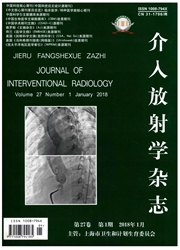

 中文摘要:
中文摘要:
目的评价急性血栓性大鼠大脑中动脉栓塞(MCAO)脑缺血造模的可行性,旨在提高模型的可重复性和可控制性。方法健康雄性成年SD大鼠60只,体重300~450g,随机分为3组:大栓子组(栓子长1.2~1.5mm,15只)、中等栓子组(0.8~1.0nun,30只)和小栓子组(0.5~0.6nun,15只)。取同系大鼠的股动脉血0.6ml与0.15ml凝血酶溶液混匀后,注入微导管内制备成线样血栓。将切好的栓子经大鼠左侧颈内动脉注入,建立MCAO模型。使用GESigna1.5T超导成像仪,3英寸环形表面线圈行大鼠脑MRI检查,并将检查结果与病理结果对照。结果小栓子组15只,9只发现脑梗死灶(60%),中等栓子组和大栓子组所有大鼠均出现脑梗死灶,小栓子组与另2组比较差异有统计学意义(P〈0.05)。中等栓子组脑梗死灶均位于同侧大脑半球,局限于左侧顶叶皮质、皮层下及基底节的占93.3%(28/30)。小栓子组9只,在24h或死亡时的平均脑梗死体积占同侧大脑半球的(14.41±8.72)%,中等栓子组30只占(48.29±18.57)%,大栓子组15只占(73.68±18.29)%。3组之间脑梗死体积比较差异有统计学意义(F=33.171,P〈0.01)。小栓子组9只,平均生存时间(301.1±23.02)h;中等栓子组30只,平均生存时间(277.43±20.27)h;大栓子组15只,平均生存时间(59.93±25.03)h。大栓子组与另2组之间生存时间比较差异有统计学意义(F=24.676,P〈0.01),而中等栓子组的生存时间与小栓子组比较差异无统计学意义(P〉0.05)。中等栓子组脑梗死区相对脑血流容量(rCBV)在3~18h内比较差异无统计学意义(F=1.578,P〉0.05)。结论经过改良后,中等栓子建立的大鼠MCAO模型脑梗死体积适中、存活率高、脑梗死部位恒定而rCBV持续降低,具有良好的可重复性和可控性。
 英文摘要:
英文摘要:
Objective To evaluate the feasibility of establishing an acute focal ischemia model of clot embolism in order to improve the repeatability and controllability. Methods An evaluation of an new thromboembolic stroke model was performed on male SD rats (n = 60)and then randomly assigned into three groups before surgery: small-size(length 0.5 - 0.6 mm, n = 15), medium-size(length 0.8 ± 1.0 mm, n = 30) and big-size(length 1.2 - 1.5 mm, n = 15)embolic groups. After preparation of the carotid artery, a catheter was introduced into the external carotid artery with injection of autologous and fibrin-rich emboli were introduced into the internal carotid artery with the common carotid artery, temporarily occluded. Relative cerebral blood volumn (rCBV)and lesion volume were determined through MRI. The comparison between MRI findings and pathologic change was analyzed. Results Cerebral infarct lesion was found in all of the rats in medium-size and big-size embolic groups, while only nine of fifteen rats (60%)exhibited cerebral ischemia in small-size embolic group, and the occurrence of cerebral ischemia in medium-size and big-size embolic groups was higher than that in the small-size group (P = 0.000). The sites of:the cerebral infarction in medium-size group were all in the ipsilateral hemisphere, and the lesions situated in the left cortex, subeortex and basal nucleus accounted for 93.33%(28/30). The mean infarction volume at 24 h or death in small-sized, mediumsize and big-size group were(14.41 ± 8.72)%, (48.29 ±18.57)% and (73.68 ± 18.29)% respectively. There were significant differences in infarct volume among the three groups (F = 33.17l, P = 0.000). The mean survival time in small-sized, medium-size and big-size groups were(301.1 ± 23.02) h, (277.43 ± 20.27) h and (59.93 ± 25.03) h respectively with significant differences (F = 24.676, P = 0.000), while no significant difference was confirmed in the mean survivals between the small-sized and the
 同期刊论文项目
同期刊论文项目
 同项目期刊论文
同项目期刊论文
 期刊信息
期刊信息
